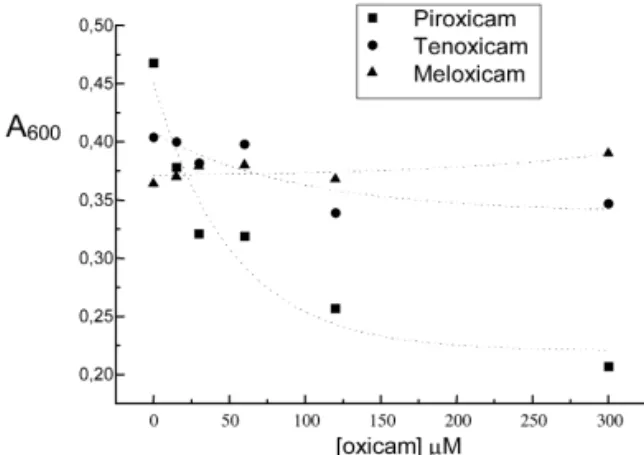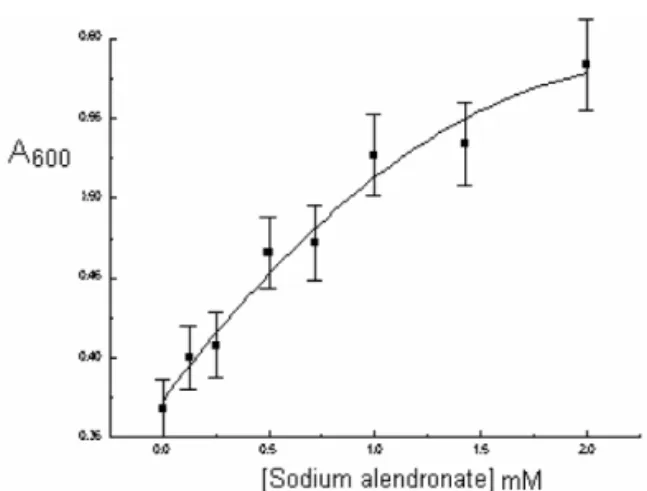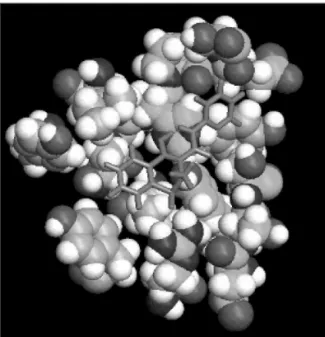Introduction
The gas gangrene or myonecrosis is a seri-ous infectiseri-ous process of fast evolution, that may arises from the contamination of wounds for its etiological agents. Although the disease is known since remote times, its etiology was only defined in the end of the XIX century, when Gram-posi-tive bacilli obligate anaerobes were isolated from infected wounds. Initially classified under the gender Bacillus, were later included in the gender Clostridium. Although the species Clostridium perfringensis more frequently isolated from gas gangrene lesions, other Clostridiumspecies also occur as its etiological agents, like C. his-tolyticum, C. septicum, C. sporogenes and C. bifermentans. These organisms, under appropriate conditions, namely, low partial tension of oxygen, multiply quickly and produce a series of toxins and hydrolytic enzymes, responsible for the pathogeny and clinical manifestations of the process. This it is characterized by extensive necrosis of the muscular and conjunctive tissues starting in the neighborhoods of the infected
www.scielo.br/eq www.ecletica.iq.unesp.br Volume 33, número 4, 2008
Inhibitors of Clostridium histolyticum colagenase
S. R. A. Leite*
Instituto de Química, UNESP, CP 355, 14801-970, Araraquara, SP, Brasil *leite@iq.unesp.br
Abstract: Different substances were tested as inhibitors of Clostridium histolyticumcollagenase, both experimental and theoretically. The in vitrocollagenase activity, alone and in the presence of inhibitors, was quantified by reaction with bovine collagen and dosage of the releasing amino acids. Collagenase-inhibitor interaction was studied theoretically by docking computational calculations. Only one among the tested substances showed inhibitor activity against the bacterial collagenase.
Keywords: Clostridium histolyticum; collagenase; inhibitors; docking.
wound, and by systemic manifestations, that increase with the development of the process. The primary cause of the necrosis is the lysis of the tis-sue structures by lytic enzymes, e.g., lecitinase, hyaluronidase, desoxi-ribonuclease and several proteases, as gelatinase and collagenase, with prominence for this last one, as one of the main responsible for the destruction of conjunctive, muscular and vascular tissues. This collagenase is obtained commercially from cultures of Clostridium histolyticum. This is the enzyme with collagenolitic activity more used in practice, for example, in the separation of cells and in derma-tological products.
Experimental
The collagenase activity was measured by collagen hydrolysis and determination of the released amino acids. The method was adapted from Mandl et al[1], in which native collagen is incubated for 5 hours with collagenase and the amino acids are colorimetrically determined by reaction with ninhydrine [2]. The reaction medi-um was buffered to pH 7,5 with Tricine 50 mM added of 0,4 M NaCl. For the inhibition trials, the ligands were mixed to the enzyme one hour before the beginning of the reaction.
The choice of substances for test was made in function of reports in the literature (experimen-tal or clinical) among common drugs with inhibit-ing effect upon collagenases. The selected drugs have different structures and pharmacological activities, but all share such inhibiting effect [3-9]. Six ligands were tested: three oxicans, namely Meloxicam, Tenoxicam and Piroxicam, tetracy-cline, doxycycline and sodium alendronate. The inhibition constant was determined for those that exhibited activity against the enzyme.
C. histolyticum collagenase (type IA) was obtained from Sigma, St. Louis, MO, USA. The drugs (ligands) were bought from Purifarma, São Paulo, SP, Brazil. The bovine collagen was produ-ced by Gelita South America, Maringá, PR, Brazil.
The computational calculations comprise the determination of the three-dimensional struc-ture of the ligands by energy minimization meth-ods, and the simulation of the interaction between ligands and collagenase active site by a docking procedure. The enzyme structure was obtained from Protein Data Bank (structure 1NQD), deter-mined by X-ray diffraction. The structures of the collagen co-crystallized with any inhibitor are not known. Therefore the area of the surface of the enzyme capable to interact with ligands had to be obtained by simulation. For this purpose, a model of a fragment of collagen, constituted by the hexa-peptide pro-pro-gly-pro-pro-gly, was positioned close to active center amino acids residues and then performed a grid calculation [10].
Docking calculation and a mixed Quantum-Classical Mechanics determination of ligand-enzyme interaction energy, led to the most probable complex structures [10, 11].
Calculations were performed on a Compaq AP400 workstation with two processors (Windows software for Classical and Quantum Mechanics energy minimization) and on a Silicon Graphics Octane workstation (Unix soft-ware for docking and ab initio Quantum Mechanics calculation). For the former it was used CAChe Worksystem 5.04 for Windows (Fujitsu Systems Business of America, Inc., Beaverton, OR, USA) [12] and for the last First Discovery 1.8 (modules: Glide; Liaison; QSite; Impact) and Jaguar 4.1. for Irix (in other words, SGI Unix) (Schrödinger Inc., Portland, OR, USA).[10, 11]
Results and Discussion
The kinetic parameters for the collage-nase-catalyzed hydrolysis of bovine collagen were determined from the plot of absorbance of ninhydrine-amino acid reaction product versus collagen concentration in mol/l, considering the protein molecular weight as 3,00 x 105 D. This system displays a standard Michaelis-Menten kinetics with a V = 1,45 µkat and Km = 19,9 µM. The specific activity results equal to 363 kat/kg.
Only Piroxicam inhibited the bacterial collagenase among all the tested drugs (Fig. 4). The others had no significant effect (including the remaining oxicans, fig. 1, doxycycline, fig. 2, and tetracycline, fig. 3), except alendronate that increased enzyme activity (Fig. 5).
Figure 3.Effect of tetracycline upon activity of C. histolyticumcollagenase.
The constant of inhibition Ki of the sys-tem Piroxicam-collagenase (constant of enzyme-inhibitor dissociation) was calculated starting from the Michaelis-Menten graph, namely:
Kma= 6,81 mg/ml = 22,7 µM V = 1,07 ∆A/5h or 1,37 µkat
Where Kma is the Apparent Michaelis Constant. Then:
Ki = Km [ I ] / Kma- Km , where [ I ] is the inhibitor concentration, [Piroxicam]. Therefore,
Ki = 1,42 mM
The maximum reaction speed measured in presence of Piroxicam was the same of the reac-tion without inhibitor, within the experimental uncertainty, what confirms the competitive nature of the process. The apparent Michaelis constant has a value only 14% greater of the true one, what implies in a relatively high Ki (1,42 mM), indicating a weak inhibitor – enzyme affin-ity. In other words, Piroxicam is a poor candidate for a drug as a bacterial collagenase inhibitor. However, maybe a good starting point to search more active derivates.
As stated above, the others ligands did not inhibit the collagenase of C. histolyticum. Curiously, the alendronate increased enzyme activity (fig. 5).
Figure 2.Effect of doxycycline upon activity of C. histolyticumcollagenase.
Figure 4.Effect of Piroxicam upon activity of C. histolyticumcollagenase, measured by absorbance at 600nm of the ninhydrine-amino acid reaction product. IC50 = 2,2 x 10-4mol/l.
The best geometries obtained through the docking calculation represent the low interaction energy between ligand-enzyme, resulting in stronger chemical bonds. Among them stand out hydrogen bonds, whose involvement of groups of enzyme active site can explain the effect on the enzymatic activity. The number and the position of hydrogen bonds formed between ligand and enzyme are described in the table 1.
All the best poses obtained in the “dock-ing” procedure were submitted to energy calcula-tion. This calculation was mixed: ab initio Quantum Mechanics, which is more accurate, for the ligand and the neighboring area of the enzyme, and Classic Molecular Mechanics for the rest of the protein, because is unviable to per-Docking calculations defined the best geometry for ligand-enzyme interaction. The best poses between each ligand and collagenase active site were select. See figure 6 as an example. Tetracycline was the only ligand for which a favor-able interaction with the enzyme was not gotten. The calculation didn’t supply any adjustment of the tetracycline with the active site that resulted in attractive interactions among their structures.
Table 1. Hydrogen bonds between ligands and
active site of Clostridium histolyticum collagenase.
Number of hydrogen bonds formed with each amino acid residue Ligands
Meloxicam Tenoxicam Piroxicam Alendronate Doxycycline
Arg 929 3 1 3 2 2
Tyr 931 -1 1 1
-Thr 957 1
-His 959 -1
-Asp 966 -1
Figure 6.Piroxicam bonding to C. histolyticum col-lagenase active site.
form an ab initio Quantum Mechanics method with a too many atoms system like a protein. The energy of the isolated ligand was obtained by the same Quantum Mechanics method and of the free enzyme by analogous mixed procedure. Classic Molecular Mechanics utilized OPLS-AA force field, and the ab initioQuantum Mechanics calculation used a density functional theory type B3LYP with a base lacvp+. Starting from these results the total ligand-enzyme bond energies were calculated, namely:
Eb = El+ Ee- Ecle
Where: Eb bond energy, El energy of ligand, Ee energy of enzyme, Ecle energy of complex ligand-enzyme. See Table 2 for the results.
Table 2. Total bond energy between ligands and
collagenase of Clostridium histolyticum.
Ligands
Meloxicam Tenoxicam Piroxicam Alendronate Doxycycline
Bond energy enzyme-lig-and (hartree)
-0,186001 -0,200768 -0,210681 -0,428059 -0,189599
alen-dronate: the worst inhibitor (actually an activa-tor) is the molecule that interacts more strongly with the enzyme. On the other hand, when simi-lar molecules are compared, as the oxicans, we see that Piroxicam is the best inhibitor and the more strongly bonding to the enzyme. The con-clusion is: first it is necessary to find the species that interact more favorably regarding the expected effect. Once found a substance like this, its structure must be modified seeking to obtain a stronger interaction that intensifies such effect. The definition of which interactions are favor-able to the inhibiting effect depends on the knowledge of which groups of the active site are important for the enzymatic activity. In the case of Clostridium histolyticum collagenase, Wilson et al. [13] identified the amino acids residues rel-evant for the enzymatic activity, through the analysis of the mutagenesis effect of each residue upon such activity. The authors concluded that:
1. Thr957, Tyr970, Leu992, Tyr994 e Tyr996 amino acids residues are very important for the bond with collagen (Tyr994 is probably the most important: its substitution reduces the activity in more than 5 times).
2. Tyr990, Tyr931, Tyr932, Asp966 e Asp974 are less important, because their loss or blockade have a small inhibition effect. 3. His959 interacts with only one of the four
collagen orientations proposed by the authors.
4. Arg929 mutation intensifies the bonding with collagen.
Based on these conclusions, we can dis-cuss the experimental results regarding docking calculations.
Initially consider the oxicans series: Piroxicam, Tenoxicam and Meloxicam. The exper-iments show that the inhibiting effect on bacterial collagenase decreases from Piroxicam to Meloxicam. According to Table 2, total interaction energy follows the exact sequence above: the more negative figure (stronger global interaction) is that of Piroxicam, following by Tenoxicam and Meloxicam bond energies. Concerning the amino acids residues that interact with the oxicans, first, the Piroxicam, although it forms three hydrogen
bonds with Arg929, whose blockade is activator, it is the only of the oxicans tested that bonds to two groups of relevance for the interaction enzyme-sub-stratum, what should generate a more efficient blockade to the approach and interaction of the enzyme with collagen. Tenoxicam and Meloxicam bond to Arg929 too and each one to a second rele-vant group for enzyme activity: Tyr931 with Tenoxicam and Thr957 with Meloxicam. However, Meloxicam bonds much more strongly to Arg929 (three hydrogen bonds) than Tenoxicam (only one), residue whose blockade is stimulating for the activ-ity, what can explain the complete absence of inhibiting effect in the case of Meloxicam.
Concerning the tested tetracyclines, it was possible to simulate the docking only with the doxycycline, because the calculation with tetra-cycline did not result in any favorable interac-tion. The calculated bond energy for doxycy-cline-enzyme is similar to that of Meloxicam-enzyme (Table 2). The hydrogen bonds between each ligand and the collagenase have much in common, namely, both bond to Arg929, residue whose blockade is activator for the enzyme, Meloxicam by three hydrogen bonds and doxy-cycline through two. On the other side, both bond to one residue whose blockade is inhibitor: Thr957 for Meloxicam and Asp966 for doxycy-cline. The former has a more intense influence upon the inhibition of the enzyme than the sec-ond, what should compensate the stronger inter-action of Meloxicam with Arg929 and to result in a similar effect comparatively to doxycycline.
Finally, Alendronate forms two hydrogen bonds with Arg929 and one with Tyr931, residue whose suppression has very little inhibiting effect. Probably the strong bond energy Alendronate-collagenase translates a very strong interaction between this ligand and Arg929, resulting in the stimulating effect upon enzyme activity of this drug.
Conclusion
References
[1] I. Mandl, J. MacLennan, E. Howes, R. DeBellis and A. Sohler, J Clin Invest 32 (1953) 1323-1329.
[2] S. Moore and W. H. Stein, J Biol Chem 211 (1954) 907-913. [3] A.Barracchini, N.Franceschini, G.Minisola,
G.C.Pantaleoni, A.Di Giulio, A.Oratore, G.Amicosante, 1999. Meloxicam and Indometacin activity on human matrix metal-loproteinases in synovial fluid. In: Greenwald,R.A., Zucker,S., Golub,L.M. (Eds.), Inhibition of matrix metallo-proteinases: therapeutic applications. New York Academy of Sciences, New York, pp. 665-666.
[4] L. M. Golub, M. Wolff and H. M. Lee, J. Periodont. Res. 20 (1985) 12-23.
[5] L. M. Golub, S. Ciancio, N. S. Ramamurthy, M. Leung and T. F. McNamara, J. Periodont. Res. 26 (1990) 321-330. [6] L. M. Golub, T. Sorsa, H. M. Lee, S. Ciancio, D. Sorbi, N. S. Ramamurthy, B. Gruber, T. Salo and Y. T. Konttinen, J. Clin. Periodont. 22 (1995) 100-109.
[7] L.M.Golub, N.S.Ramamurthy, A.Llavaneras, M.E.Ryan, H.M.Lee, Y.Liu, S.Bain, T.Sorsa, 1999. A chemically modi-fied nonantimicrobial tetracycline (CMT-8) inhibits gingival
matrix metalloproteinases, periodontal breakdown, and extra-oral bone loss in ovariectomized rats. In: Greenwald,R.A., Zucker,S., Golub,L.M. (Eds.), Inhibition of matrix metallo-proteinases: therapeutic applications. New York Academy of Sciences, New York, pp. 290-310.
[8] R. A. Greenwald, L. M. Golub, N. S. Ramamurthy, M. Chowdhury, S. A. Moak and T. Sorsa, Bone 22 (1998) 33-38. [9] O.Teronen, P.Heikkila, Y.Konttinen, M.Laitinen, T.Salo, R.Hanemaaijer, A.Teronen, T.Sorsa, 1999. MMP inhibition ad downregulation by biphosphonates. In: Greenwald,R.A., Zucker,S., Golub,L.M. (Eds.), Inhibition of matrix metallo-proteinases: therapeutic applications. New York Academy of Sciences, New York, pp. 453-465.
[10] I. Schrödinger, First Discovery: Technical notes for ver-sion 1.8. Schrödinger, Inc., Portland, OR, 2001.
[11] I. Schrödinger, Jaguar User’s Guide. Version 4.1 Schrödinger, Inc., Portland, OR, 2001.
[12] I. Fujitsu, CAChe 5.0 for Windows User Guide Fujitsu Systems Business of America, Inc., 2001.
[13] J. J. Wilson, O. Matsushita, A. Okabe and J. Sakon, The EMBO Journal 22 (2003) 1743-1752.
Pay attention that, the calculations for steric adjustment and bond formation between ligands and enzyme active center (“docking”) and to obtain bond energies values are very useful in the interpre-tation of the experimental results. But, as every method of computational simulation, they have their limitations and their results should be considered with caution. They must be considered as an aid for interpretation of the experiences and for planning news ones, but not as their substitutes.
Acknowledgements
The author is grateful to Fundação de Amparo à Pesquisa do Estado de São Paulo (FAPESP) for financial support.
Received May 28 2008 Accepted September 16 2008
S. R. A. Leite. Inibidores da colagenase do Clostridium histolyticum
Resumo: Diferentes substâncias foram testadas como inibidores da colagenase do Clostridium his-tolyticum, dos pontos de vista experimental e teórico. A atividade da colagenase, isolada e na presença das substâncias testadas, foi medida através da reação de hidrólise do colágeno bovino e dosagem dos aminoácidos liberados. A interação inibidor-enzima foi estudada teoricamente, mediante simulação computacional de ancoragem. Das substâncias testadas, somente uma apresentou atividade inibidora sobre a colagenase bacteriana.


